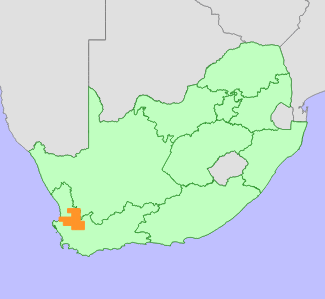|
Scientific Name | Serruria aitonii R.Br. |
Higher Classification | Dicotyledons |
Family | PROTEACEAE |
Synonyms | Serruria argentifolia E.Phillips & Hutch. |
Common Names | Marshmallow Spiderhead (e), Spiderhead (e), Spinnekopbos (a) |
National Status |
Status and Criteria | Least Concern |
Assessment Date | 2019/05/22 |
Assessor(s) | A.G. Rebelo, H. Mtshali & L. von Staden |
Justification | Serruria aitonii has a restricted range with an extent of occurrence (EOO) of 7192 km². There are many subpopulations known and this species is abundant occurring as dense stands of individuals. The existing threats are unlikely to cause the populations to decline severely in the near future. It is therefore listed as Least Concern. |
Distribution |
Endemism | South African endemic |
Provincial distribution | Western Cape |
Range | This species is endemic to the mountains of the Western Cape Province, South Africa, where it occurs from the Cederberg and Sandveld to the Groot Winterhoek Mountains and the Piketberg. |
Habitat and Ecology |
Major system | Terrestrial |
Major habitats | Piketberg Sandstone Fynbos, Winterhoek Sandstone Fynbos, Cederberg Sandstone Fynbos, Olifants Sandstone Fynbos, Swartruggens Quartzite Fynbos |
Description | It occurs on montane, rocky sandstone slopes, 100-1700 m. Mature individuals are killed by fires, and only seeds survive. Seeds are released after ripening, and dispersed by ants to their underground nests, where they are protected from predation and fire. It is pollinated by insects. |
Threats |
| At least 8% of this species' habitat has been lost to agriculture in the lowland areas of the Piketberg and Cederberg. Currently, there are no severe significant threats to this species. Most of its remaining habitat is in rocky, montane areas where the rate of loss is significantly lower than in the lowlands. Alien invasive plants have been observed in low densities in some parts of its range. |
Population |
Plants occur in dense stands. Subpopulations tend to be isolated from one another (Rebelo, 2001). The population is stable, and is not suspected to be declining.
|
Population trend | Stable |
Assessment History |
Taxon assessed |
Status and Criteria |
Citation/Red List version | | Serruria aitonii R.Br. | Least Concern | Raimondo et al. (2009) | |
Bibliography |
Goldblatt, P. and Manning, J.C. 2000. Cape Plants: A conspectus of the Cape Flora of South Africa. Strelitzia 9. National Botanical Institute, Cape Town.
Manning, J.C. and Goldblatt, P. 2012. Plants of the Greater Cape Floristic Region 1: The Core Cape Flora. Strelitzia 29. South African National Biodiversity Institute, Pretoria.
Raimondo, D., von Staden, L., Foden, W., Victor, J.E., Helme, N.A., Turner, R.C., Kamundi, D.A. and Manyama, P.A. 2009. Red List of South African Plants. Strelitzia 25. South African National Biodiversity Institute, Pretoria.
Rebelo, T. 2001. Sasol Proteas: A field guide to the proteas of southern Africa. (2nd ed.). Fernwood Press, Vlaeberg, Cape Town.
|
Citation |
| Rebelo, A.G., Mtshali, H. & von Staden, L. 2019. Serruria aitonii R.Br. National Assessment: Red List of South African Plants version . Accessed on 2025/05/31 |
 Comment on this assessment
Comment on this assessment

